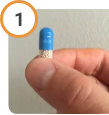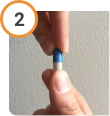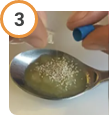Per meal
500-1,000 lipase units/kg
Dosing & administration for adult patients with EPI due to chronic pancreatitis (CP) or pancreatectomy (PY)
CREON is the only FDA-approved, enteric-coated PERT specifically studied in adult patients with EPI due to CP or PY
Recommended starting dosage for your adult patients with EPI due to CP or PY
Per snack
Half dose of established meal dosing
If symptoms of malabsorption persist, increase dosage
- Titrate dosage to either 2,500 lipase units/kg per meal, 10,000 lipase units/kg/day, or 4,000 lipase units/gram of fat ingested per day
CP and PY Pivotal Trial1,2
Efficacy and safety of CREON 72K per meal and 36K per snack were established in adult patients with EPI due to CP/PY.
Getting started with CREON 36K1
Specific dosing for adult EPI patients with CP/PY
 During meals |
 During snacks |
CREON 36K may not be appropriate for all patients. CREON is also available in 3K, 6K, 12K, and 24K lipase unit capsules.
Capsules shown are not actual size and do not represent the exact color shade. For illustrative purposes only. The active ingredient in CREON evaluated in clinical trials is lipase.
- CP/PY study: Patients received either placebo or 72,000 units of lipase per main meal (3 main meals) and 36,000 units per snack (2 snacks) while consuming ≥100 g of fat per day1,2
- Usually, half of the prescribed CREON dose for an individualized full meal should be given with each snack1
- Adverse reactions that occurred in at least 1 CP or PY patient (greater than or equal to 4%) receiving CREON were hyperglycemia, hypoglycemia, abdominal pain, abnormal feces, flatulence, frequent bowel movements, and nasopharyngitis1
After starting your patient on CREON, follow up as early as 5-7 days* to assess the need for a dose adjustment1
Dose adjustments should be individualized based on1:
Clinical signs and symptoms
Degree of steatorrhea present
Dietary fat content
*In clinical studies, improvement in fat absorption after treatment with CREON could be assessed as early as 5-7 days.
CREON should be taken with every meal and snack, with sufficient fluid. Capsules should not be crushed or chewed.1


CREON dosing tips
Hear from gastroenterologist Shahab Mehdizadeh, MD, as he shares tips for dosing CREON in patients with EPI due to CP or PY.
Dosing and administration considerations
- Fibrosing colonopathy has been reported following treatment with pancreatic enzyme products. Do not exceed the recommended dosage of 2,500 lipase units/kg/meal (or 10,000 lipase units/kg/day) or 4,000 lipase units/g fat ingested/day in adult and pediatric patients greater than 12 months of age without further investigation.
- Start at the lowest recommended dosage and individualize the dosage based on clinical symptoms, the degree of steatorrhea present, and the fat content of the diet.
- CREON should not be crushed, chewed, or retained in the mouth. CREON should always be taken with food.
- If a dose is missed, the next dose should be taken with the next meal or snack. With each snack, administer approximately half the prescribed CREON dose for a meal.
- CREON should be kept in a dry place and in the original container.
Encourage patients to use the Treatment Tracker to record their symptoms, dietary habits, and administration routines and share it with you at their next follow-up appointment.
Get educational resources, support program details, and prescription savings information for your patients and practice.
EPI = exocrine pancreatic insufficiency.




